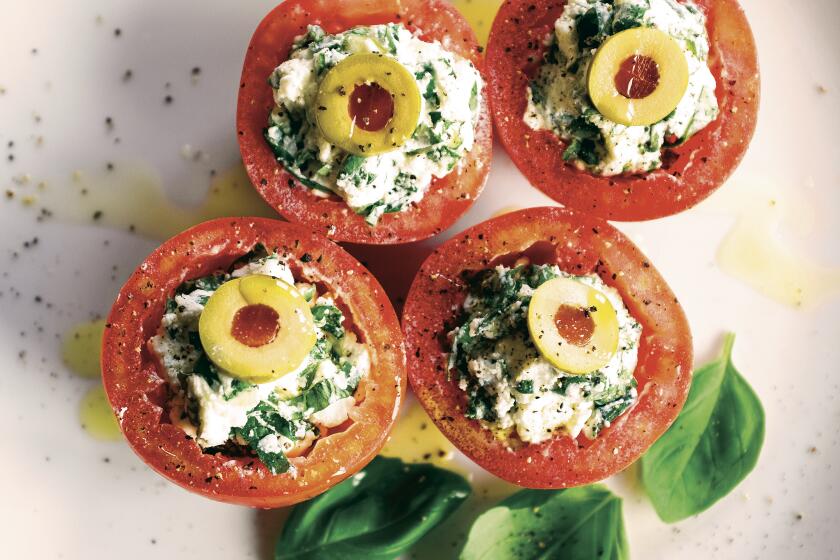Hurry-up slow-cooked strawberry preserves

- Share via
Edon Waycott’s strawberry jam tastes like strawberries, only more so. Strawberries squared. Strawberries to the nth degree.
It could be that this is the way jam used to taste before we stopped making our own and started buying the processed stuff. But one can’t be sure that the jams of yesteryear were ever quite this good. Waycott’s jam is the nearest thing to a garden in a bottle.
While conserving fruit is considered an art in France, Waycott is lost for words at how to describe herself. “I wouldn’t know what to put on a business card,” she jokes. She describes jam-making as one of a continuum of pursuits. Since art college in New York in the ‘60s, these have included painting, fabric design and cookery writing, including a book on jam, “Preserving the Taste” (Hearst, 1993).
It was a passion for bread, she says, that led her to experiment with jams. This took the form of a collaboration with chef Mark Peel and baker Nancy Silverton, proprietors of Campanile restaurant and La Brea Bakery. She devised the jam recipes for both places.
The day we visit her ranch house bordering the Santa Monica Mountains in Malibu, the scent of strawberries carries out of the house, across the courtyard, clear to the driveway.
Inside the kitchen, 8 quarts of strawberries simmer in a wide, surprisingly shallow copper-lined French braising pan. “People always think they should be jam-making in a deep pot,” she says. “When you don’t use commercial pectin, you want the evaporation.” The secret, she sums up, is slow cooking in a wide-mouth pot.
At first, her accumulated wisdom tumbles out in a succession of dos and don’ts. Don’t use frozen fruit, or bruised or rotten produce, she warns. Good jam starts with the fruit.
The strawberries simmering before her come from up the Pacific Coast Highway in Oxnard. They were bought at the Santa Monica farmers market a day earlier. After rinsing and hulling the berries, the first step is to macerate them in sugar and “a little lime juice” overnight. “It draws out the juices,” she explains.
She reserves extra emphasis for the next rule. “Don’t,” she says, “cut them up. Leave them whole.” Pureed strawberry jam, she says, “is just red.”
The next trick is the slowest possible cooking. “Don’t add water,” she says. The art is removing the water, allowing the fruit to cook down to the point that the three cartons of fruit are captured in an 8-ounce jar.
As the pot of strawberries nears ready, Waycott darts into a larder to retrieve jams that she made earlier--much earlier. As she sets out elegantly labeled little jars, the strictures subside and enchantment sets in. Waycott cannot quite conceal the rapture behind these neat little vessels. They sum up a year in her garden.
From winter, there are citrus marmalades: grapefruit and orange and Meyer lemon. “It’s so aromatic,” she says, practically purring as she uncaps the Meyer lemon.
Then she offers a jam she knows will stump the taster. It is an amber jelly that is neither tart nor sweet. If there were an ale for bees, this would be it. “It’s guava,” says Waycott, gleaming. “As you cook it, it looks like dishwater. But as it cooks, it turns amber. It’s so exotic.”
Within minutes of tasting the guava jelly, we are outside a pair of garden doors, being instructed to pinch blossoms off a nearby blooming pineapple guava hedge. “Eat them!” she cries. They are succulent, slightly sweet and, again, arrestingly strange. “I have trouble leaving any flowers for fruit,” she confesses. “I could eat every blossom on the tree.”
And so begins the tour of Waycott’s real love: her garden. To love jam, one realizes, one must love fruit. For Waycott, to love fruit is to grow it. She leads us past trees and shrubs that will bear mulberries, blood oranges, apricots, lemons. There are Satsumas, plums, pomegranates. Of course, grapes--Concord and Muscat.
It is tempting to go on about the unusual varieties (the mulberries are Persian mulberries, the apricots Royal Blenheims, etc.) or 65 varieties of old roses, or the herb garden where pennyroyal and savory thrive, or the native California lilacs.
But suffice it to say here that if this small, intense woman were a bird, she would be a hummingbird. Waycott spends her days on missions for nectar. Once she captures it, she preserves it with rare and wondrous perfectionism.
Lightly rinse the berries without submerging them in water. Remove the hulls, leaving the berries whole. Combine the berries, sugar and juice in a nonaluminum bowl. Allow them to macerate at room temperature, stirring occasionally, for at least 3 to 4 hours. The mixture can be covered and refrigerated overnight at this point.
Pour the mixture into a wide, shallow 6-to 8-quart saucepan and set the pan over high heat. Bring to a boil, skim the foam that collects on the surface, then reduce the heat to low. Make sure bubbles continue to break the surface. After about 20 minutes, the berries will give up additional juices and appear to be floating. Continue cooking them, stirring more often, and skimming the foam for about 1 hour.
The jam is almost done when it turns dark red and the ratio of berries to juice is about equal. Watch and stir the jam often. See tips for doneness and canning instructions.
Get our Cooking newsletter
Get a taste of Los Angeles — and the world — with recipes and kitchen tricks from the L.A. Times’ Cooking newsletter.
You may occasionally receive promotional content from the Los Angeles Times.















